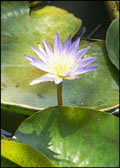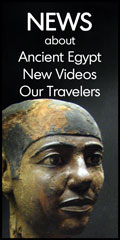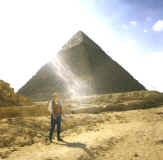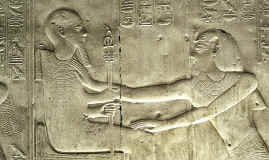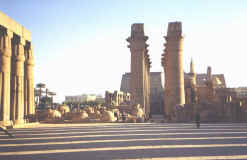Our
upcoming Egyptologists'
Egypt Tour also
includes Tel el-Amarna and Middle Egypt.
Open to non-Egyptologists as well!
|
Tel-Amarna,
Middle Egypt, Cairo & Luxor |
Day-by-Day Itinerary
|
CLICK all pictures to ENLARGE. Use BACK arrow to return to page. Day
0, Fri., Feb 11, 2005: For those beginning their tour in New York, USA,
our plane leaves NY City on Friday evening, February 11, 2005.
Your American Tour Leader, Ruth Shilling, meets the group at JFK airport
in New York City and accompanies the group on the flight to Egypt.
We fly direct non-stop from New York city, USA to Cairo, Egypt. Other
departure cities in the USA are available as add-on's. Contact
Us for pricing.
Day
1, Sat., Feb 12:
Midday arrival in Cairo (7 hours ahead of New York time, 2 hours ahead
of Greenwich). Cairo is the biggest center of culture and learning
in the Middle East, and one of the largest, most crowded cities in the
entire world. We begin with a panoramic view of the whole city
from the Citadel. Here we also visit one of the most
beautiful mosques in the city, the famous Mohammed Ali Mosque, also
called the "Alabaster Mosque".
Day 5, Wed: We leave Giza early this morning to begin this very special opportunity to see Tel-Amarna and Middle Egypt. We travel south via our own private A/C bus to Middle Egypt. At this time only about 15 people a week visit the sites in Middle Egypt (not like the thousands that visit Giza each day), so this is quite an opportunity. We begin with a visit to the Pyramid at Meidum. As we get our first look at it from a distance, this pyramid is strangely beautiful . It has a very arresting quality, even though its sides have slid down and it is not in a good condition. Inside, we can touch some of the wooden timbers used in its construction. Imagine touching wood that is more than 4,000 years old! This is also the site where the famous statues (on display in the Cairo museum) of Rahotep and his wife were found. Our visits to sites from the Middle Kingdom (2040 - 1640 BC) begin with the tombs at Beni Hasan. The nobles' tombs portray scenes from the daily life, and are well preserved, full of color and quite fascinating. Acrobatics, dancing, and military sports are emphasized. But there are also scenes of making flour, baking bread, weaving cloth, and even a husband and wife on their wedding night! There are also many animals - both those that were domesticated and those that were hunted. There are also a few "mystic" beasts to speculate about, a unicorn... or what do you think? It
is near Beni Hasan that we find another interesting site, the "Speos
Artemidos," a rock cut temple for Pakhet, an aspect of the
lioness goddess Sekhmet. It is here that the female pharaoh,
Hatshepsut, made her declaration denouncing the Hyksos and telling of
her mission to resuscitate the temples of Egypt. We will see how
she seeded the spiritual renaissance of the New Kingdom when we get to
Luxor. Day 6, Thurs: This morning visit the site of Tel-Amarna, a city built by Akhenaten and Nefertiti during the New Kingdom. We visit some nobles tombs with wall reliefs unequalled anywhere else in Egypt. The pictures appear alive and even as though they are moving. We also visit the Northern Palace, one of the markers of the city limits (a huge stone with hieroglyphics), the Southern Palace and the tomb which was built for Akhenaten. In
the afternoon we visit el-Ashmunein (Arabic), Hermopolis
(Greek), Khmunu (Ancient Egyptian) or the "City of
the Eight". It was the main cult center of Thoth (Djhueti,
Tehuti), god of Wisdom and writing, patron of scribes. We also visit
Tuna el-Gebel which was the neocropolis of Khmunu.
All in all, a very exciting day.
Early evening arrival in Luxor, where we settle to our 5-star hotel overlooking the Nile.
Next we see the rarely visited Ramesseum, a favorite of many of our travelers. There are some exciting excavations going on there presently, and we may be privileged to get a closer look. Perhaps the most colorful tombs presently available for viewing in Luxor, the Workman's Village, Deir El Medina, gives us a look at some of the tombs most often represented in books about Ancient Egypt. Whereas on Monday we saw scenes of daily life during the Old Kingdom, and on Wednesday we saw scenes from the Middle Kingdom, today we see the daily life represented during the New Kingdom (about 1,000 years and 500 years later). As we leave the West Bank of Luxor we see the "Colossi of Memnon," the two large statues of Amenhotep III that still stand, even though their temple was long ago destroyed. We return to the East Bank where we visit the Luxor Temple in the late afternoon-early evening (when the lighting is optimal for seeing the wall reliefs). The dramatic lighting also helps give the temple a special feeling in the evening. Both gently beautiful and full of awesome grandness, this temple was the "Bride of Karnak" during the annual Apet festival.
Today we make a second visit to the West Bank of Luxor. The west represented the hereafter and is where the dead were buried. We have already visited the tombs in the Valley of the Workmen, so today we visit the famous Valley of the Kings (where King Tut’s tomb was found).
Return
flight to Cairo this evening or
board a Nile Cruise boat to continue your Egypt tour with a Nile Cruise
extension provided by our affiliate, American Express of Egypt. An extension
is offered for a Nile Cruise and Abu
Simbel Excursion . |
| Feb 22-27, 2005 | Nile Cruise with American Express of Egypt |
| Feb 26, 2005 | Abu Simbel (by air) with AmEx |
All Photos on
this page are by Ruth Shilling,
except the Sun Temple - taken by one of our travelers, Ken Reynolds.

